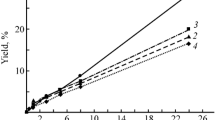Summary
Drag reduction was studied in dilute toluene solutions of a mixture of two polymers: polyisobutylene (of three different molecular weights) and 1,4-cis-isoprene rubber in the turbulent region at low (up to 5000) Reynolds numbers. Experiments were carried out with mixed solutions at a concentration equal to optimum concentration of polyisobutylene or higher than it. Drag reduction of the polymer mixtures depending on the ratio of the two polymers showed a positive deviation from the additive straight line at all concentrations investigated. To evaluate the degree of deviation from additivity, the excess drag reduction, was introduced which represents the difference between the actually measured drag reduction and that read from the additive straight line. The excess drag reduction showed almost no dependence on the molecular weight of polyisobutylene in the investigated range of this magnitude. Deviation from additivity depending on the ratio of the two polymers in the mixture growed higher with increasing the flow rate at a given molecular weight of polyisobutylene. The highest excess drag reduction was observed in solutions containing a larger amount of the lower molecular isoprene rubber polymer. The effect of polymer coils on drag reduction in binary polymer solutions was studied. An assumption was made that higher drag reduction in the polymer mixtures as compared to the additive was due to the change of polymer coil dimensions caused by the copresence of the macromolecules of both polymers in the solution. It was further supposed that low shear stresses at which the experiments were carried out caused sufficient orientation and deformation of isoprene rubber enlarged molecules and the contribution of the latter in increasing drag reduction of the mixture was higher.
Zusammenfassung
Die Widerstandsverminderung in verdünnten toluolischen Lösungen einer Mischung von zwei verschiedenen Polymeren wird untersucht. Verwendet werden Polyisobutylene (mit drei verschiedenen Molekulargewichten) und 1,4-cis-Isopren-Kautschuk, und es wird im turbulenten Bereich bei Reynolds-Zahlen bis zu 5000 gemessen. Die Versuche werden bei Konzentrationen, die der Optimalkonzentration von Polyisobutylen entsprechen, oder höheren Konzentrationen durchgeführt. Die Widerstandsverminderung der Polymermischungen zeigt bei allen untersuchten Konzentrationen eine positive Abweichung von der additiven Geraden, deren Größe vom Mischungsverhältnis abhängt. Zur Beschreibung der Abweichung vom additiven Verhalten wird die „überschüssige Widerstandsverminderung“ (excess drag reduction) eingeführt, welche die Differenz zwischen dem wirklich gemessenen Wert und dem zugeordneten Wert auf der additiven Geraden beschreibt. Diese Größe zeigt nur eine geringe Abhängigkeit vom Molekulargewicht der eingesetzten Polyisobutylene. Die Abweichung vom additiven Verhalten als Funktion des Mischungsverhältnisses beider Polymeren wächst mit zunehmendem Volumenstrom. Die größte überschüssige Widerstandsverminderung wird in Lösungen beobachtet, die einen größeren Anteil des weniger hochmolekularen Isopren-Kautschuks enthalten. Der Einfluß der Polymerverknäuelung auf die Widerstandsverminderung wird betrachtet. Es wird angenommen, daß die überschüssige Widerstandsverminderung auf eine Änderung der Knäuelgröße infolge der Anwesenheit des jeweils anderen Polymeren in der Lösung zurückzuführen ist. Weiter wird vermutet, daß die relativ niedrigen Schubspannungen, bei denen die Versuche ausgeführt wurden, doch schon eine hinreichend starke Orientierung und Deformation der aufgeweiteten Isopren-Kautschuk-Moleküle bewirken, so daß deren Beitrag zur Erhöhung der Widerstandsverminderung überwiegt.
Similar content being viewed by others
Abbreviations
- D :
-
diameter of capillary
- DR :
-
drag reduction
- DR add :
-
additive drag reduction
- ΔDR :
-
excess drag reduction,ΔDR = DR − DR add
- DR mixture :
-
theoretical drag reduction of the mixture
- DR *mixture :
-
actually measured drag reduction of the mixture
- DR 1R :
-
drag reduction of an IR molecule in a separate IR solution
- DR *1R :
-
drag reduction of an IR molecule in the presence of molecules of another polymer in the solution
- DR PIB :
-
drag reduction of a PIB molecule in a separate PIB solution
- DR *PIB :
-
drag reduction of a PIB molecule in the presence of molecules of another polymer in the solution
- L :
-
length of the capillary
- \(\dot V\) :
-
flow rate
- c :
-
concentration
- n :
-
number of IR molecules
- p :
-
number of PIB molecules
- τ w :
-
wall shear stress
- CMC:
-
carboxymethylcellulose
- IR:
-
isoprene rubber
- PAA:
-
polyacrylic acid
- PAM:
-
polyacrylamide
- PEI:
-
polyethyleneimine
- PEO:
-
polyethylene oxide
- PIB:
-
polyisobutylene
- PS:
-
polystyrene
References
Dingilian, G., E. Ruckenstein Amer. Ind. Chem. Engg. J.20, 1222 (1974).
Parker, C. A., T. A. Joyce J. Appl. Polym. Sci.18, 155 (1974).
Dschagarowa, E., G. Mennig Rheol. Acta16, 309 (1977).
Dschagarowa, E., G. Mennig Rheol. Acta14, 1089 (1975).
Little, R. C., R. L. Patterson J. Appl. Polymer Sci.18, 1529 (1974).
Kuhn, R., H.-J. Cantow Makromol. Chemie122, 65 (1969).
Kulesnev, V. N., L. S. Krochina Vysokomol. soed.15A, 906 (1973).
Author information
Authors and Affiliations
Rights and permissions
About this article
Cite this article
Dschagarowa, E., Bochossian, T. Drag reduction in polymer mixtures. Rheol Acta 17, 426–432 (1978). https://doi.org/10.1007/BF01525958
Received:
Issue Date:
DOI: https://doi.org/10.1007/BF01525958




